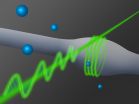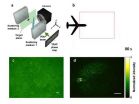(Press-News.org) THE cancer drug eribulin, originally developed from sea sponges, could give women with advanced triple negative breast cancer an average of five extra months of life, according to research presented at the National Cancer Research Institute (NCRI) Cancer Conference in Liverpool today (Monday).
Researchers led by Professor Chris Twelves, based at the University of Leeds and Leeds Teaching Hospitals NHS Trust, looked at two major clinical trials of more than 1,800 women with breast cancer that had started to spread to other parts of the body. The phase III trials – the final stage of testing before deciding whether a drug can be prescribed to patients – compared the survival of women treated with eribulin* to those given standard treatment.
The two studies showed an overall improvement in survival of more than two months for women treated with eribulin**. The most significant improvement was seen in women with the advanced triple negative form of breast cancer, where there are limited treatment options; these women's survival improved by nearly five months. There was also a survival boost of more than two months for women with the HER2 negative form of breast cancer***.
Cancer spreading to other organs – called metastasis – is responsible for around 90 per cent of all cancer deaths. And, when patients with breast cancer are diagnosed after the disease has started to spread, 10-year survival is around one in 10, compared to nearly nine in 10 for those diagnosed at the earliest stage.
Study author, Professor Chris Twelves, said: "Our results show a substantial improvement in survival for women with metastatic triple negative breast cancer, and a more modest, but significant, benefit for those with HER2 negative breast cancers.
"Eribulin has previously been offered to women who've already been through several lines of chemotherapy. But the European Union has recently approved eribulin for patients who have received less treatment for their breast cancer, which means we hope to give more patients another treatment option in the not-too-distant future.
"Despite advances in the diagnosis and treatment of women with breast cancer, more than 11,600 women still die from invasive breast cancer each year in the UK. New and better treatments are needed for people fighting the disease."
Eribulin works by stopping the cancer cells from separating into two new cells. It is a type of drug called a microtubule inhibitor. Eribulin was originally developed from a sea sponge called Halichondria okadai but is now made in the laboratory.
Martin Ledwick, head information nurse at Cancer Research UK, said: "These results are encouraging and may offer valuable extra time to patients whose cancers have stopped responding to conventional treatments and have few options left. Advanced breast cancer can be very difficult to treat so these results take us a small, important step in the right direction.
"Although eribulin isn't a cure, it's an extra treatment option for patients with advanced breast cancer, which can be priceless to them and their families."
INFORMATION:
Read the full conference abstract - http://conference.ncri.org.uk/abstracts/2014/abstracts/A036.html
*Eribulin (also called eribulin mesylate or Halaven) is a chemotherapy drug used to treat advanced breast cancer. It is usually given to people who have already had at least two other courses of chemotherapy. Eribulin works by stopping (inhibiting) the cancer cells from separating into two new cells. It is a type of drug called a microtubule inhibitor.
** Overall survival for women treated with eribulin was 15.2 months, compared to 12.8 months for women given standard therapies. Women with HER+ breast cancer saw no statistically significant improvement.
*** HER2 stands for human epidermal growth factor receptor. It is a protein found in small amounts on some normal cells, including breast cells, stomach cells and bladder cells. It is one of the proteins involved in cell growth. Some cancers have cells with large amounts of this protein and they are called HER2 positive. These cancers can be treated with drugs that target the HER2 protein. If a cancer does not have large amounts of the HER2 protein it is called HER2 negative.
Triple negative breast cancers are cancers that don't have receptors for oestrogen, progesterone or Her2. Only around 15 out of every 100 breast cancers (15%) are triple negative.
Sea sponge drug could boost advanced breast cancer survival by 5 extra months
2014-11-03
ELSE PRESS RELEASES FROM THIS DATE:
The Lancet Diabetes & Endocrinology: Weight loss surgery substantially reduces the risk of developing type 2 diabetes
2014-11-03
Bariatric (weight loss) surgery, such as gastric bypass or gastric banding, could reduce the risk of developing type 2 diabetes by around 80% in obese people, compared with standard care, new research published in The Lancet Diabetes & Endocrinology journal suggests.
Being overweight or obese is the main modifiable risk factor for type 2 diabetes. More than 80% of adults with type 2 diabetes are overweight or obese [1]. In England, just over a quarter of adults (26%) were classified as obese in 2010 (body mass index [BMI] 30kg/m2 or over)[2]. Up to 3% of people with ...
Getting more out of nature: Genetic toolkit finds new maximum for crop yields
2014-11-02
Cold Spring Harbor, NY – Scientists at Cold Spring Harbor Laboratory (CSHL) today announced a new way to dramatically increase crop yields by improving upon Mother Nature's offerings. A team led by Associate Professor Zachary Lippman, in collaboration with Israeli colleagues, has discovered a set of gene variations that can boost fruit production in the tomato plant by as much as 100%.
Plant breeders will be able to combine different gene variants among the set to create an optimal plant architecture for particular varieties and growing conditions. The set of mutations ...
Sediment supply drives floodplain evolution in Amazon Basin
2014-11-02
A new study of the Amazon River basin shows lowland rivers that carry large volumes of sediment meander more across floodplains and create more oxbow lakes than rivers that carry less sediment.
The findings have implication for the Amazonian river system, which may be significantly altered by proposed mega-dams that would disrupt sediment supplies.
Researchers from Cardiff University's School of Earth and Ocean Sciences examined 20 reaches within the Amazon Basin from Landsat imagery spanning nearly 20 years (1985 to 2013).
They found rivers transporting larger amounts ...
Study: 'Wimpy' antibody protects against kidney disease in mice
2014-11-02
CINCINNATI—An antibody abundant in mice and previously thought to offer poor assistance in fighting against infection may actually play a key role in keeping immune responses in check and preventing more serious self-inflicted forms of kidney disease, researchers say.
Led by researchers at the University of Cincinnati (UC) and Cincinnati Children's Hospital Medical Center and published online Nov. 2, 2014, in the journal Nature, the study finds that the mouse antibody IgG1, which is made in large quantities and resembles a human antibody known as IgG4, may actually ...
Two photons strongly coupled by glass fiber
2014-11-02
Two photons in free space do not interact. Light waves can pass through each other without having any influence on each other at all. For many applications in quantum technology, however, interaction between photons is crucial. It is an indispensable prerequisite for transmitting information through tap-proof quantum channels or for building optical logic gates. At the Vienna University of Technology (TU Wien), scientists have now succeeded in establishing a strong interaction between two single photons. This opens up completely new possibilities for quantum optics. The ...
Improving imaging of cancerous tissues by reversing time
2014-11-02
As a child, it was fascinating to put a flashlight up to our palms to see the light shine through the hand. Washington University in St. Louis engineers are using a similar idea to track movement inside the body's tissues to improve imaging of cancerous tissues and to develop potential treatments.
Lihong Wang, PhD, the Gene K. Beare Distinguished Professor of Biomedical Engineering at the School of Engineering & Applied Science is applying a novel time-reversal technology that allows researchers to better focus light in tissue, such as muscles and organs.
Current ...
Mutant models
2014-11-02
Nate Silver and Richard Feynman walk into a bar and bump into a biologist . . .
While this may sound like the setup to some late-night nerd sketch, researchers have taken this premise and applied it to an increasingly cumbersome problem in modern biology, namely, finding meaning in the rising oceans of genomic data.
In this specific instance, the data comprisesreams of cancer mutations that genome-wide studies are publishing at a dizzying rate. The challenge is finding new and efficient ways to parse the signal from the noise (and there is no shortage of noise).
As ...
Ultracold disappearing act
2014-11-02
A disappearing act was the last thing Rice University physicist Randy Hulet expected to see in his ultracold atomic experiments, but that is what he and his students produced by colliding pairs of Bose Einstein condensates (BECs) that were prepared in special states called solitons.
Hulet's team documented the strange phenomenon in a new study published online this week in the journal Nature Physics.
BECs are clumps of a few hundred thousand lithium atoms that are cooled to within one-millionth of a degree above absolute zero, a temperature so cold that the atoms march ...
New technique efficiently turns antibodies into highly tuned 'nanobodies'
2014-11-02
Antibodies, in charge of recognizing and homing in on molecular targets, are among the most useful tools in biology and medicine. Nanobodies – antibodies' tiny cousins – can do the same tasks, for example marking molecules for research or flagging diseased cells for destruction. But, thanks to their comparative simplicity nanobodies offer the tantalizing prospect of being much easier to produce.
Unfortunately, their promise hasn't been fully realized, because scientists have lacked an efficient way of identifying the nanobodies most closely tuned to their ...
'Invisible tattoos' could improve body confidence after breast cancer radiotherapy
2014-11-02
Invisible tattoos could replace the permanent dark ink tattoos used to ensure that breast cancer patients having radiotherapy are treated in exactly the same spot during each session, according to results from a pilot study to be presented at the National Cancer Research Institute (NCRI) Cancer Conference today (Sunday)*.
Research suggests that the permanent pin prick marks made on the skin of women having radiotherapy reminds them of their diagnosis for years to come, reducing body confidence and self-esteem.
It's also more difficult to spot these tattoos in dark-skinned ...


